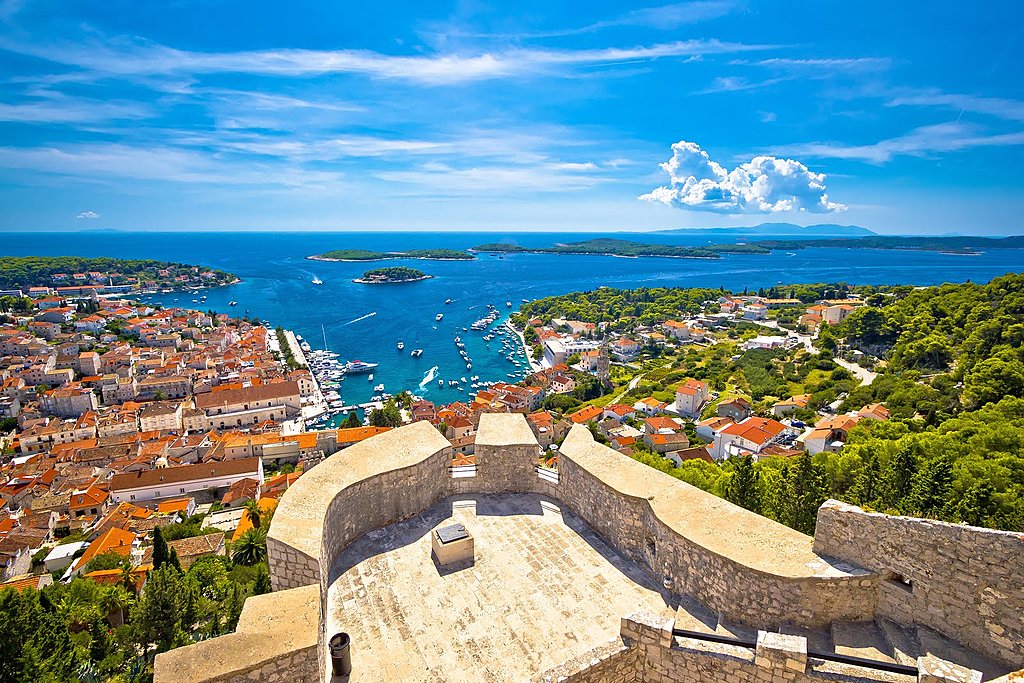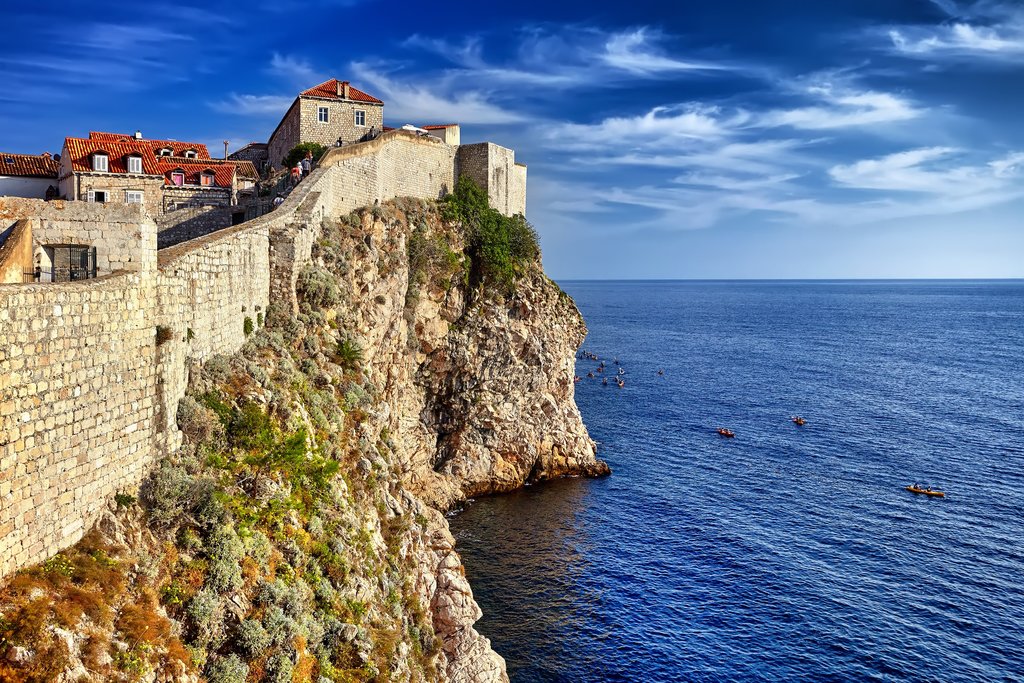Highlights
- Visit the open-air markets of Ban Jelacic Square in medieval Zagreb
- Admire the impressive Skradinski Buk waterfalls in Krka National Park
- Listen to the music of Zadar's sea organ as you take in a sunset
- Marvel at Split's stone sphinxes brought back from Egypt 3,500 years ago
- Explore the 16th-century stone walls of Dubrovnik's Lovrijenac and Revelin fortresses
Brief Itinerary
| Day | Highlights | Overnight |
|---|---|---|
| Day 1 | Arrive in Zagreb & Guided Walking Tour | Zagreb |
| Day 2 | Transfer to Plitvice Lakes National Park | Plitvice Lakes National Park |
| Day 3 | Transfer to Zadar, Explore | Zadar |
| Day 4 | Transfer to Split, Visit Krka National Park | Split |
| Day 5 | Ferry to Hvar, Sea Kayaking Around Pakleni Islands | Hvar Town |
| Day 6 | Hvar Wine Tasting | Hvar Town |
| Day 7 | Ferry to Dubrovnik, Explore | Dubrovnik |
| Day 8 | Depart Dubrovnik |
Detailed Itinerary
Day 1: Arrive in Zagreb & Guided Walking Tour

Start your adventure in Zagreb, the capital of Croatia. Upon arrival at the airport, you'll be transferred to your hotel to settle in. The rest of the day is yours to spend as you like. The city center is easily walkable, and the streets and parks are easy to navigate on foot. All the main attractions and restaurants are within walking distance.
A gem of a European city, Zagreb is at once historic and new. It's filled with leafy green parks and Gothic/neo-renaissance buildings, yet there are also modern shopping complexes, outdoor malls, and endless dining and drinking options. Consider heading out on a guided walking tour of the historic heart of the city. This involves walking from the main square to Zagreb's Upper Town and passing through local markets before reaching St. Mark's Square.
Alternatively, you can visit one of the many museums and art galleries, like the Homeland War Museum, the Nikola Tesla Technical Museum, or the ever-popular Museum of Broken Hearts. Or stroll through the city center, enjoying 17th-century neo-baroque architecture found at Zagreb's Art Pavilion and Croatian National Theater.
Zagreb also has a number of beautiful city parks, which are great for exploring and people-watching, especially in the late afternoon. Maksimir is a great option, with a variety of cafés nearby to pick up a coffee for your stroll.
Day 2: Transfer to Plitvice Lakes National Park

Today, you'll make the drive south to Plitvice Lakes National Park, one of Croatia's most popular national parks. Along the way, make a point to stop at Rastoke. Rastoke is a small village known for its old watermills and beautiful waterfalls as two rivers converge in the area. This is a nice precursor of the sights to come at Plitvice Lakes.
A short drive later, you'll arrive at Plitvice Lakes National Park in the early afternoon and can explore the park at your leisure. A must-visit for any traveler to Croatia, the UNESCO-protected park is comprised of an exquisite collection of 16 glassy emerald green and blue travertine lakes, more than 90 cascading waterfalls that seemingly cover every corner of the park and numerous caves. The terraced lakes are surrounded by beech and pine forests and are home to extensive wildlife.
Choose one of eight different hiking trails, ranging from three to eight hours in duration, where the upper lakes tend to be less crowded during the peak season. You may wish to bring a bought lunch (and a bottle of wine!) with you to enjoy a picnic. Tickets are purchased at the entrance of the Park.
Driving time (Zagreb to Rastoke): 1.5-2 hours
Day 3: Transfer to Zadar, Explore

In the morning, continue your drive south from Plitvice to the ancient Roman city of Zadar. A historical center of the Dalmatian Coast, Zadar is famous for its picturesque coastline full of islands and vibrant blue waters, as well as fresh seafood and unforgettable sunsets.
Take the rest of the day to relax and explore. You may wish to stroll along Zadar's Riva, a wide ribbon of stone paths bordered by a grassy park on one side and the sea on the other. It runs along Old Town's waterfront, where it comes alive at night with vendors and Dalmatian capella groups called Klapa that serenade the passersby, including folks on yachts who dock there.
Take in a legendary sunset (Alfred Hitchcock is on record saying they're the best in Zadar) from Café Brazil before discovering the pretty patterned lights of the Monument to the Sun while listening to the nearby Sea Organ.
Driving time: 1.5-2 hours
Chat with a local specialist who can help organize your trip.
Day 4: Transfer to Split, Visit Krka National Park

After breakfast, you'll drive south toward Split, stopping at Krka National Park and the charming coastal towns of Primošten and Trogir. With seven waterfalls—the largest and most impressive being Skradinski Buk—Krka National Park is one of eight national parks in Croatia. The Krka River, another highlight of the park, carves through the limestone and creates a spectacular canyon on its 44-mile journey (70 km) from the foothills of the Dinaric Alps to Šibenik.
Follow the winding wooden paths that traverse emerald pools to viewpoints of the majestic series of falls and enjoy a quick swim if the mood strikes. One great section to explore starts at Skradinski Buk. From there, head to Roški Slap, where you can take a short walk across the river to a small set of rapids, said to resemble a pearl necklace from above. At Roški Slap, you can stop to grab a bite to eat locally-produced prosciutto, cheese, and seasonal salads.
Come mid-afternoon, travel farther south to Split, settling into your hotel before taking the rest of the afternoon to wander its historic center. Start at Pjaca Square for pretty views of white marble tiles, the Iron Gate (the western entrance to Diocletian's Palace), a Romanesque clock tower with the remains of a medieval sundial, and the 15th-century Town Hall. Next, visit the popular Voćni trg or Fruit Square to enjoy Renaissance architecture, influenced during Split's Venetian era.
For a bit of shopping and a bite to eat, head to Marmont Street, though you'll want to find your way to the waterfront to catch the sunset.
Driving time (Zadar to Krka): 1-2 hours
Driving time (Krka to Split): 1.5 hours
Day 5: Ferry to Hvar, Sea Kayaking Around Pakleni Islands

This morning, catch the ferry to the island of Hvar and check into your hotel. A Croatian island in the Adriatic Sea, Hvar is a popular destination with tourists due to its natural setting, mild climate, and its historic port town of the same name. Highlights of Hvar Town include its 13th-century walls, a hilltop fortress, and the main square anchored by the Renaissance-era Cathedral.
For some of the best views of the island, Hvar Town, and the nearby Pakleni Islands, take a short walk up to the 16th-century Španjola Fortress. Or, join a kayaking tour and head out on the Adriatic to discover the many secluded coves that outline the islands. To cover some ground and appreciate the variation in the island landscape: from lavender plantations and olive groves to vineyards and pine woods, you may like to join a (wine-tasting) cycling or hiking tour. The less active might opt to rent a scooter for faster coverage of the local scenery.
After the day's adventures, treat yourself to a drink in the ancient piazza of Hvar, overlooking the Venetian loggia, 7th-century fortification walls, and the oldest municipal theater in Europe.
Ferry time: 1.5-2 hours
Day 6: Hvar Wine Tasting

Join a half-day wine tour to sample some of Croatia's best wines. Immerse yourself in wine country, less than half an hour inland from Hvar Town, and tour wineries, meeting winemakers and exploring UNESCO-protected vineyards where grapes have grown since the time of the ancient Greeks. Hvar's fertile, rich soil produces the rich plavac mali red, grown both locally and on the Dalmatian coast, as well as Bogdanuša, a dry white special to the island.
One of the island's most beloved wineries is Tomić, run by Andro Tomić, a well-known winemaker who's famous for his statement, "The way you should drink wine is per hour, not per liters." A popular stop for travelers, be sure to ask to see the basement, which was inspired by the substructures of Diocletian's Palace in Split. Other suggested wineries are Duboković and Plenković.
Day 7: Ferry to Dubrovnik, Explore

After breakfast, board a four-hour ferry to Dubrovnik. Often referred to as the "Pearl of the Adriatic," Dubrovnik is a world-renowned city of exceptional charm. Take some time to explore its 16th-century stone walls, including the Minceta, Lovrijenac, and Revelin fortresses, visit Onofrio's Fountain and the Church of Saint Blaise (St. Vlaho), and stroll along the limestone-paved Stradun, Dubrovnik's main street to get your bearings. Dubrovnik also offers excellent nightlife and some of Croatia's best restaurants and wine bars.
The remainder of the day will be at your leisure, allowing time for you to wander and explore the city. Depending on when you arrive, you may have time to hop aboard a cable car and ride to the top of Srđ Mountain for stunning views of Dubrovnik and the nearby Elafiti Islands. Here you can explore the 19th-century Fort Imperial (built during the Napoleonic Wars) before stretching your legs and walking back down the hill, enjoying views of the city below.
Day 8: Depart Dubrovnik

Depending on when you depart, you may have time to visit one of Dubrovnik's museums, like the Franciscan Monastery and Museum. This large complex houses many treasures, including the world's third-oldest pharmacy dating from 1317.
Alternatively, for a collection of 15,000 pieces of interesting works, visit the Rector's Palace and Cultural Historical Museum. Wander this well-preserved palace-turned-museum and explore its exhibits, some detailing life in the Republic of Ragusa during medieval times. The drive to the airport from Dubrovnik takes around 45 minutes with normal traffic.
More Great Croatia Itineraries
Looking for more inspiration for your trip to Croatia? Check out these other Croatia itineraries, explore different ways to spend eight days in Croatia, or discover the best time to visit Croatia.


